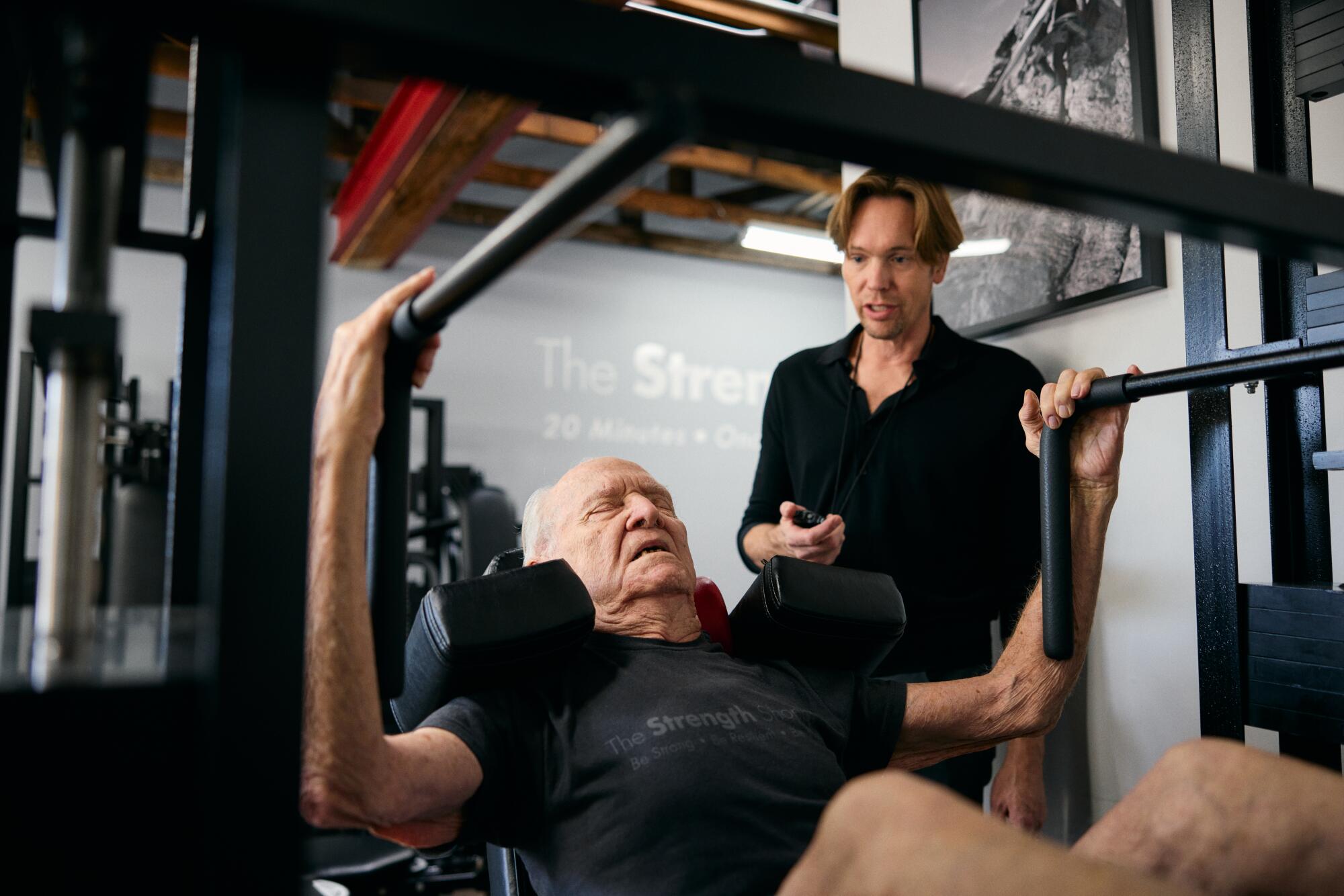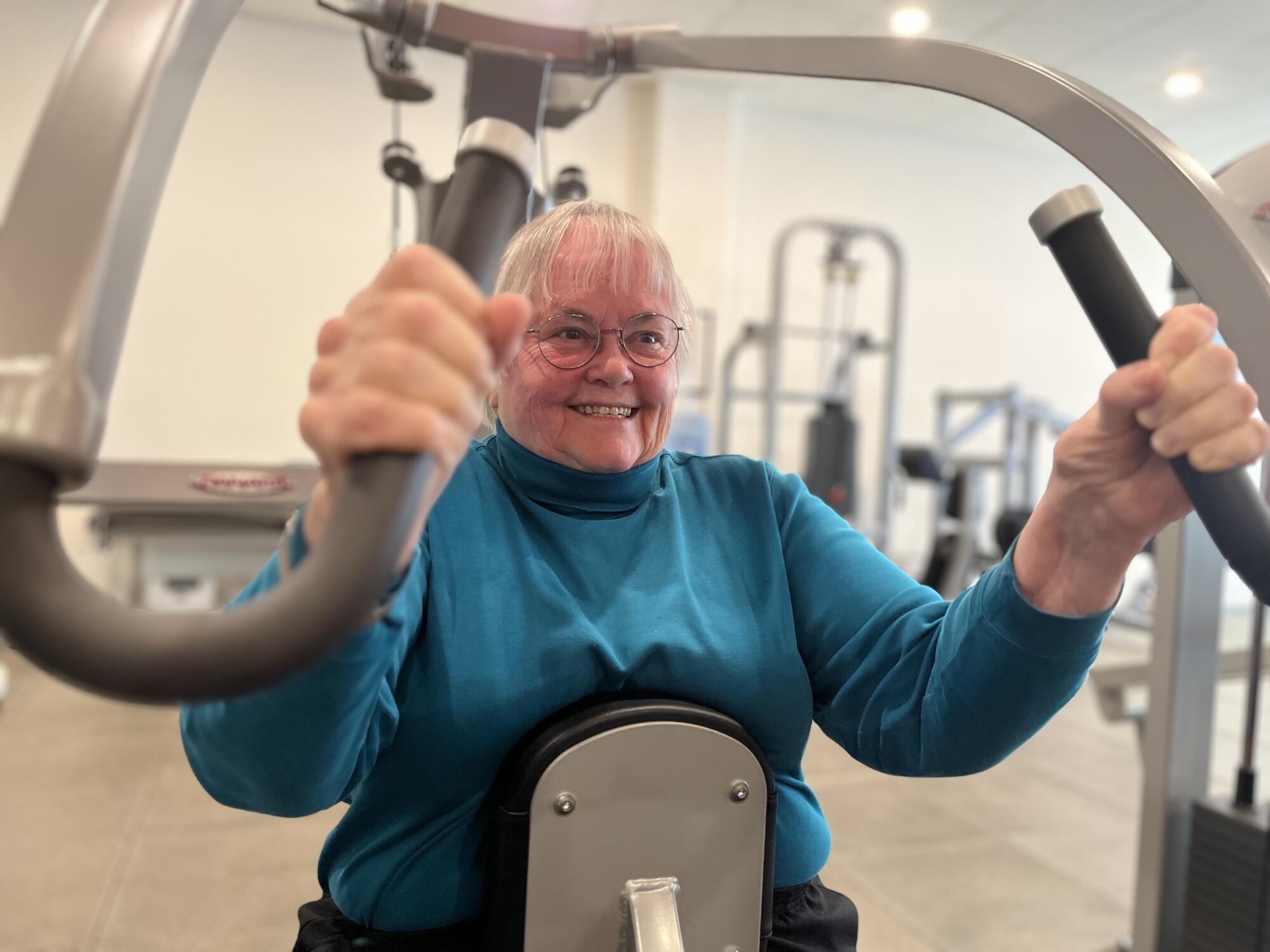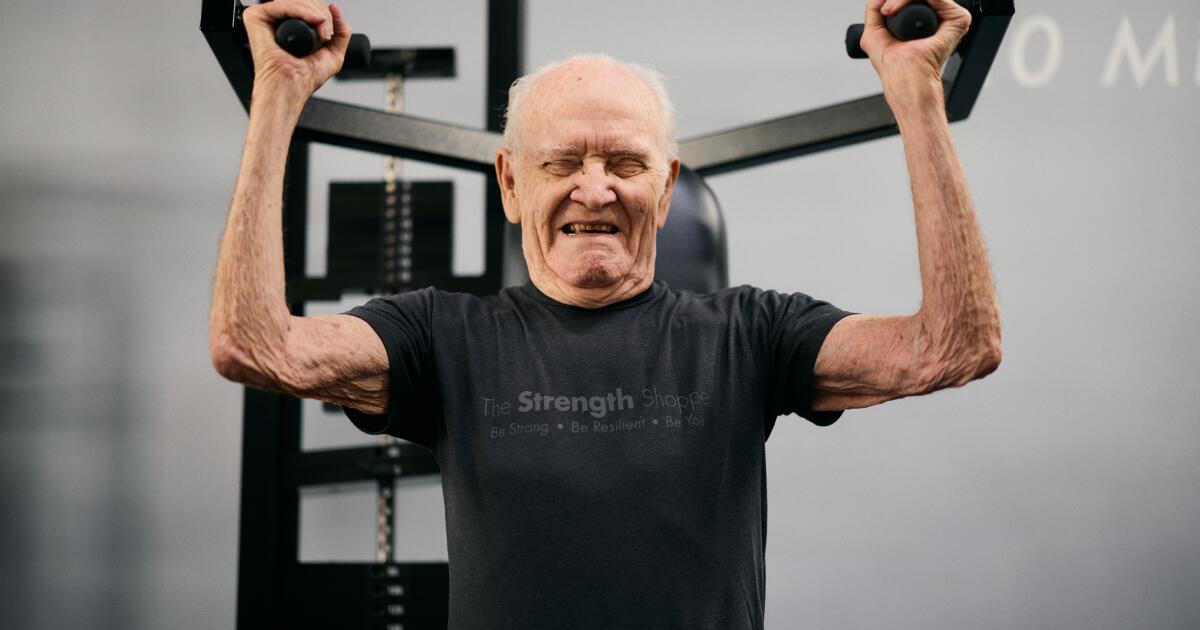DeLoyce Alcorn is 92 years old — and pressing nearly four times that in weight at the gym.
On a recent Wednesday afternoon, Alcorn — dressed in a T-Shirt that read “Be Strong. Be Resilient. Be You.” — slid into the leg press machine, which was set at a whopping 312 pounds. He gripped the handlebars, closed his eyes and “got zen,” as he says. Then he pressed his legs forward very slowly.
“Slower, slower, smoooooth ….” urged his his trainer, standing by his side.
The retired aerospace engineer, who lives in Sierra Madre, did about four reps before his teeth clenched, his legs trembled and he let out short puffs of air through pursed lips. The exercise was just one minute and thirty-three seconds long. When it was over, Alcorn sprung to his feet, beaming triumphantly.
“I used to do 400 pounds!” he boasted. “But the COVID, it put me back. I’m working my way back.”
Alcorn was in the midst of his weekly workout at the Strength Shoppe in Echo Park, where he and his wife, Patricia Alcorn, 88, have been training for 12 years. They’re devotees of an exercise called slow-motion strength training. Often referred to as SuperSlow or Power of Ten, the resistance training technique involves lifting weights very slowly and methodically, with 10 seconds each spent on the lifting and lowering motions of the exercise. Doing so eliminates momentum and is therefore easier on the joints and connective tissue — one reason many fans of slo-mo training are in their golden years.
Patricia Alcorn, 88, works out with her trainer, Melinda Hughes, at the Strength Shoppe.
(Marcus Ubungen/Los Angeles Times)
The workout is typically done using MedX equipment, weight machines that were developed in the 1980s for rehabilitative purposes. They’re still used in physical therapy clinics, hospitals and gyms around the country.
Recently, strength training has become a hot topic in the world of exercise, in part because research continues to show its benefits for health and longevity. It builds muscle strength and bone density and is good for cardio metabolic health, especially for women. But slow-motion strength training, in particular, is beneficial for older exercisers, people healing injuries or those who are new to or returning to exercise because the slow cadence and focus on form — always with one-on-one supervision — reduces the chance of injury.
The method has also caught the attention of the wider exercise community because of its efficiency: a slow-motion workout is just 20 minutes long, once a week. It shouldn’t be done more than that, so the body has time to recover, says Melinda Hughes, co-owner of the Strength Shoppe. Slowing down the movement, eliminating momentum and not stopping to rest during an exercise set puts the muscle under greater tension for a longer period of time, forcing it to work harder, so exercisers may see greater benefit in less time compared with traditional strength training. Muscles typically fatigue from the exercise in just one to two minutes.
“Whereas traditional strength training takes three times the amount of time, with more reps and sets,” Hughes says, “and you don’t get to the level of intensity that you do with slow-motion strength training, where you just do one set to failure.”

Lai-San Ho on the rowing torso machine at the Workout Revolution with trainer Lorena Ortiz.
(The Workout Revolution )
“It’s only 20 minutes. I can go on my lunch break!” says Lai-San Ho, a 33-year-old TV editor. She started slow-motion strength training at the Workout Revolution in Studio City after tearing her ACL in 2022 — it provided a low-impact way to exercise while recovering. But she stuck with it to stay fit.
“I could tell I was getting stronger in all areas of my body,” Ho says. “I’ve noticed certain aches and pains in my upper back, after a year, went away. I can’t imagine not doing it because I feel so many benefits.”
Jason Zaremski, a sports medicine physician at the University of Florida, says the technique is “legit, the real thing.”
“Any weight training is great for older individuals, but this routine reduces risk of injury while still gaining benefit,” he says. “There’s no jerky motions or throwing of weights. And it can increase your circulation — you get greater blood flow while activating your muscles. So you’re adding a cardiovascular benefit for something that’s typically anaerobic.”
Even so, other experts are skeptical about the technique.
“Sets going to failure, with a long time under tension, is a very uncomfortable, unnecessarily painful workout,” Casey Johnston, author of the weightlifting newsletter “She’s a Beast,” said. “It’s not necessarily more effective. So much of lifting is about coordination, neuromuscular activity in your body and stabilization and that’s not present using machines the way it is with free weights.”

DeLoyce Alcorn and his trainer, Arjen van Eijmeren, at the leg press machine.
(Marcus Ubungen/Los Angeles Times)
There are about a dozen boutique fitness studios in L.A. that specialize in slow-motion strength training, as well as larger chains like the Perfect Workout. Though many of them have been around for decades, momentum around this subset of exercise picked up during the COVID-19 pandemic, Hughes says, adding that by 2022, the Strength Shoppe had doubled its staff at both its Pasadena and Echo Park locations and this month opened a Mid-City location. While gyms and fitness studios closed during early stay-at-home orders, many slow-motion strength training studios remained open because they offered an essential rehabilitative service: weight-bearing physical therapy for pain management, osteoporosis and other conditions.
Word got out. Then, after restrictions lifted, those looking for in-person studios with strong COVID protections found their way to slow-motion strength training. The environment of a typical studio is quieter and more intimate than a bustling gym. No more than two clients and their trainers are typically allowed in the space at once. The temperature is set at a chilly 68-70 degrees, because body heat rises with such strenuous exertion. There are typically no group classes offered and no music over the loudspeakers.
“It’s so absolute attention can be paid to form and alignment,” Hughes says, adding that her clientele ranges from age 12 to 93. “I, and other trainers who work with this, call it ‘the fountain of youth.’ We lose muscle and bone density as we age. It’s cumulative. When you gain — or regain muscle mass — you feel younger, your body is more supported.”

Melinda Hughes and Arjen van Eijmeren, owners of the Strength Shoppe.
(Marcus Ubungen/Los Angeles Times)
At SuperSlowLA in Brentwood, which opened 25 years ago, the clientele ranges from age 15 to 89. But the studio specializes in the health of postmenopausal women, who make up 80% of its business (90% of its clients are female).
“Women get osteoporosis and osteopenia and other related health issues because of hormonal changes,” says owner Benjamin Fisher. “A lot of our clients are afraid of walking down the street and breaking a hip. The methodology of what we do, we keep bone loss at bay. We give them the strength to be more active and independent.”
Leona Katz, an 80-year-old attorney who has been training at SuperSlowLA for five years, calls the results “miraculous.”
“I was very overweight and had hip problems and blood pressure problems,” Katz says. “After my husband passed away, I made some life changes and lost more than 100 pounds. My kids call me Leona 2.0.”
At Myogenics Fitness, which opened in West Hollywood in 1998, the atmosphere is clean, simple and functional. Occasionally the studio will play white noise to help exercisers focus. Trainers coach clients on how to keep their breathing open and fluid while they lift.
“A lot of people compare it to mediating,” owner Chad Morris says of the workout.

Marty Waldman, 96, performs pull-downs at Myogenics Fitness.
(Carlin Stiehl/For The Times)
Marty Waldman, 96, has been training at Myogenics for about six years, which has been “very gratifying but also exhausting” as a nonagenarian, he says. He was a runner, skier and long-distance biker when he was younger, and is in relatively good shape today but for a heart condition and “two bad knees and shoulders.” But the retired businessman began slo-mo strength training because he wanted to feel stronger.
“It’s allowed me to do things I wouldn’t ordinarily do,” he says. “We just got back from a rigorous trip with the gorillas in Rwanda — there’s no way I could have done that if I hadn’t been in reasonably decent shape.”

Chad Morris, owner of Myogenics Fitness, holds a stopwatch while training Marty Waldman, 96.
(Carlin Stiehl/For The Times)
Though slow-motion strength training has delivered clear results for many of its participants, those results come with a price: Sessions must be done with a trainer and typically cost between $80 and $100, so that a month’s worth of sessions are more than a monthly gym membership.
There are safety precautions too.

Marty Waldman’s progress is recorded on his workout chart at Myogenics Fitness.
(Carlin Stiehl/For The Times)
“You can’t do the same amount of weight that you’d do with a traditional routine,” says sports medicine physician Zaremski. “You may have to drop the weight because your muscles will fatigue quicker — they’re under tension for a longer period. Your form also needs to be especially accurate.”
Still, devotees say the cost is worth it.
“You cannot put a price on health,” says Blake Boyd, a 58-year-old actor-producer and former fitness trainer who came to the Strength Shoppe six years ago after having been diagnosed with arthritis in his neck. “It’s effective, it works. I’ll do it for the rest of my life.”
Rick Staddon, owner of Vitality Personal Training in Calabasas, says his clients comment that getting stronger has been a game-changer.
“I often hear: ‘I can carry groceries up the stairs now,’ ‘I can cut the grass,’ he says. “The simple things are very meaningful for a lot of people.”

Alanna Kathleen Brown lifts weights at Pure Strength in Studio City.
(Deborah Vankin/Los Angeles Times)
For Alanna Kathleen Brown, an 80-year-old retired English professor, slow-motion strength training has turned her into a “walking miracle,” she says, climbing onto the seat of the High Row machine at Pure Strength in Studio City.
“I have osteoarthritis, I deal with obesity, I have blood pressure issues and GERD,” Brown says. “But I do weights. I’m strong. I’ve avoided surgeries.”
Then she lifts and lowers the weight very slowly until her cheeks are flushed pink.
“For me, doing slow weights is right up there with paying all the bills,” she says. “I’d give up a lot of things before I’d give this up. Because it’s quality of life — and independence.”

